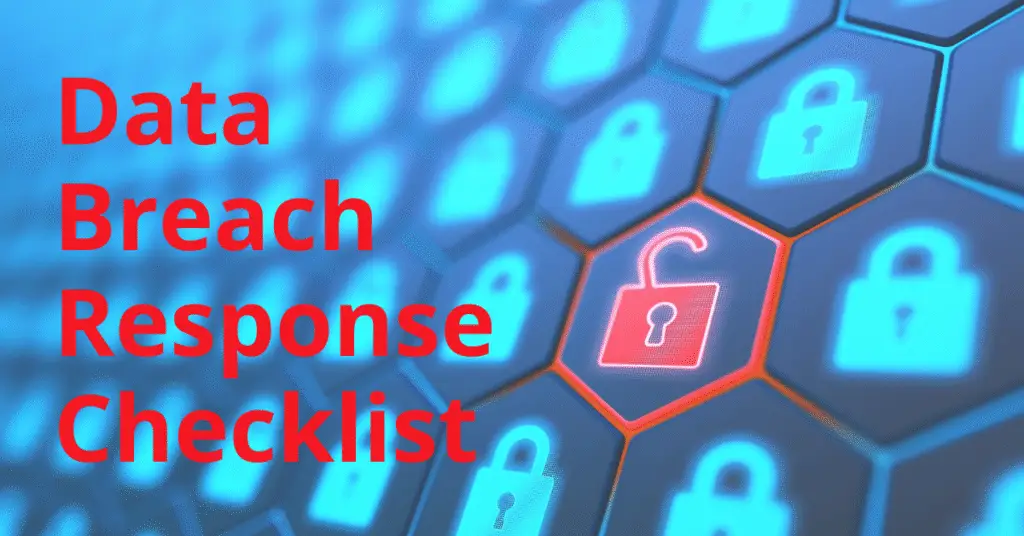
Key Takeaways
- Activate incident response and confirm scope fast.
- Contain systems, preserve evidence, start forensics immediately.
- Meet regulator and customer notice deadlines precisely.
- Restore from trusted backups and validate controls.
- Record actions, review findings, improve governance.
A data breach response checklist provides a structured framework that helps organizations act quickly and compliantly when sensitive information is compromised. It defines each step required for detection, containment, notification, and recovery to reduce financial, operational, and reputational risks.
Think of your company as a ship sailing across unpredictable digital waters. A data breach is that sudden storm that appears without warning, but your response checklist is the compass, anchor, and lifeboat combined. When every crew member understands their role and every system is ready, even the roughest waves can be navigated safely. Preparation is no longer optional; it is the difference between a controlled course correction and a complete loss of direction.
What should an organization do immediately after discovering a data breach?
When a breach is detected, the organization must first confirm its validity, activate the incident response plan, and begin containment measures. These actions ensure that damage is limited, evidence is preserved, and regulatory obligations are met from the outset.
In practical terms, this phase is the equivalent of a ship’s captain spotting turbulent waters and ordering the crew to secure all decks before the storm intensifies. Early confirmation prevents panic, while an activated response plan aligns every team, including technical, legal, and executive groups, toward the same objective of controlling impact. Rapid coordination at this stage determines whether the incident becomes a short disruption or a long-term crisis.
Immediate priorities include:
- Verification and logging: Confirm indicators of compromise, record timestamps, and classify the incident severity.
- Containment: Isolate affected systems, disable compromised credentials, and implement emergency network rules.
- Communication: Notify executive leadership, legal counsel, and cybersecurity leads through predefined channels.
- Documentation: Begin a continuous record of all response actions for audits and potential investigations.
By treating the first hour as the “golden hour,” organizations can contain the breach before it spreads, preserve forensic integrity, and set the foundation for an efficient recovery.
How should an organization contain and recover from a data breach?
Once the immediate threat is identified, containment must begin to prevent the breach from spreading. Recovery should follow through structured remediation, data restoration, and continuous validation of security controls to restore business operations safely.
Containment is about stabilizing the situation before repair begins. It is similar to a ship sealing watertight compartments to stop flooding before attempting repairs. In cybersecurity, this means isolating affected systems, closing attack vectors, and ensuring no hidden entry points remain. Recovery, on the other hand, focuses on restoring systems to a trusted state while ensuring vulnerabilities that caused the breach are fully addressed.
Core containment and recovery actions include:
- System isolation: Quarantine compromised servers, disable unauthorized access, and restrict network connections.
- Vulnerability remediation: Patch exploited flaws, update configurations, and reinforce access controls.
- Data restoration: Restore information from verified, secure backups that are free from compromise.
- Forensic analysis: Engage cybersecurity experts to investigate root causes and ensure all malicious traces are removed.
- Validation: Perform system integrity checks, security scans, and compliance verification before resuming normal operations.
The effectiveness of this phase lies in balancing urgency with precision. Containing too slowly allows greater damage, while rushing recovery without validation risks reintroducing vulnerabilities. A deliberate and evidence-based approach ensures operational stability and long-term resilience.
How should an organization manage notifications and regulatory communication after a data breach?
After containment, organizations must comply with all legal notification requirements and communicate transparently with regulators, customers, and other stakeholders. These communications must be accurate, timely, and aligned with the laws governing each jurisdiction where affected data resides.
This step can be compared to a ship sending out distress signals to the proper authorities while keeping passengers informed about the situation. Silence or misinformation creates confusion and damages credibility. Likewise, effective communication during a breach demonstrates governance, accountability, and trustworthiness.
Key notification and communication priorities include:
- Regulatory compliance:
- Under the GDPR, notify the supervisory authority within 72 hours of discovering a personal data breach if it poses a risk to individuals’ rights and freedoms.
- Public companies must follow SEC regulations, disclosing material cyber incidents within four business days of determining their significance.
- HIPAA and various U.S. state laws impose additional timelines for notifying affected individuals and regulatory bodies.
- Internal alignment: Ensure legal, communications, and executive teams review all messages before release.
- Stakeholder communication: Provide clear, factual updates to affected individuals, partners, and media without speculation or blame.
- Documentation: Maintain detailed records of when, how, and to whom notifications were sent, along with supporting evidence.
Accurate communication is both a legal requirement and a demonstration of integrity. When done correctly, it reinforces public trust, supports regulatory confidence, and strengthens your organization’s position during any subsequent review or investigation.
How should governance and internal communication be managed during a data breach?
Strong governance and disciplined communication form the backbone of an effective breach response. Leadership must establish a clear chain of command, maintain documented decision-making, and ensure that all internal updates are verified before distribution. This approach prevents misinformation, duplication of efforts, and regulatory missteps.
In operational terms, this is similar to a ship’s captain maintaining control of the bridge while ensuring that all crew members receive the same instructions through an organized communication channel. When authority and information flow are clear, even the roughest situations can be managed with composure and consistency.
Governance and communication best practices include:
- Defined command structure: Assign an incident commander and document roles, escalation paths, and responsibilities across teams.
- Single source of truth: Maintain one authoritative incident report that consolidates technical updates, business impact assessments, and communication drafts.
- Timely executive briefings: Keep leadership informed of verified developments, regulatory requirements, and potential reputational implications.
- Secure internal communication: Use protected collaboration platforms and avoid personal messaging tools to prevent leaks or data mismanagement.
- Controlled external messaging: Coordinate all statements through approved communication and legal channels to ensure compliance and accuracy.
When governance and communication function together, organizations demonstrate control rather than crisis. Consistency, transparency, and documentation become the guiding principles that protect the organization’s reputation and align teams toward recovery.
How should an organization approach recovery and validation?
Recovery begins once systems are contained and the root cause is understood. The objective is to restore data and services safely while verifying that all vulnerabilities have been addressed. Validation confirms that the environment is secure, compliant, and operationally sound before returning to normal business activity.
This phase is like inspecting a ship after a storm. Every system, cable, and control must be checked before sailing again. The process demands precision, not speed. Recovery without validation risks another breach, while a well-tested return builds confidence across the organization and with regulators.
Essential recovery and validation steps include:
- Data restoration: Retrieve information only from verified, uncompromised backups.
- Integrity checks: Validate restored files, configurations, and access controls.
- Operational testing: Conduct functional and security tests to ensure stability.
- Continuous monitoring: Strengthen detection and alerting systems to identify anomalies early.
- Compliance review: Confirm that restoration steps align with legal and regulatory expectations.
Successful recovery is measured not only by system uptime but also by improved resilience and verified security posture.
What lessons should be learned after a data breach?
Post-incident analysis transforms a crisis into a foundation for long-term improvement. Every breach should trigger a formal review of causes, response actions, and control gaps. The goal is to update policies, enhance monitoring, and strengthen prevention measures for future incidents.
This stage mirrors a ship’s debrief once it returns safely to port. The captain and crew review navigation logs, weather data, and mechanical performance to ensure better preparation for the next voyage. The same mindset applies to cybersecurity—learn from every challenge and convert findings into stronger systems.
Critical post-incident actions include:
- Root cause analysis: Identify exact weaknesses that enabled the breach.
- Policy enhancement: Update security protocols and response playbooks.
- Training reinforcement: Re-educate teams based on observed gaps in awareness or response timing.
- Framework alignment: Map improvements to updated standards such as NIST Cybersecurity Framework 2.0.
- Performance review: Track metrics for response time, containment speed, and notification accuracy.
Lessons learned are not documentation exercises; they are commitments to organizational maturity and future preparedness.
How does 4Comply strengthen breach readiness and response?
4Comply simplifies compliance and data governance during and after a breach. It provides centralized tools to manage consent records, track regulatory notification timelines, and automate documentation workflows. This structure ensures that communication with authorities and customers remains accurate and timely.
In operational terms, it functions as the ship’s navigation system—tracking every route, updating maps, and ensuring compliance with maritime laws before each voyage. 4Comply delivers confidence that your response will meet every regulatory expectation with precision and clarity.
Key benefits include:
- Automated generation of regulator-ready reports and notifications.
- Integrated consent and subject-rights management for accurate outreach.
- Workflow tracking that supports audits and investigations.
- Dashboards that visualize risk exposure and compliance posture.
With 4Comply, organizations replace manual, reactive efforts with a proactive compliance framework that is consistent and audit-ready.
Conclusion with CTA
A well-designed data breach response checklist transforms uncertainty into control. It ensures that each phase—detection, containment, notification, recovery, and review—is executed with discipline and documentation. Much like a skilled crew guiding a vessel through turbulent seas, prepared organizations manage crises calmly and emerge stronger.
If your organization is ready to modernize its breach response, automate compliance, and reinforce accountability, connect with 4Thought Marketing to learn how 4Comply can help you stay secure and compliant under any condition.
Frequently Asked Questions (FAQs)
What is a data breach response checklist?
It is a documented process that outlines the steps an organization must follow to detect, contain, report, and recover from a data breach.
How quickly must a breach be reported under GDPR?
Organizations must notify the supervisory authority within 72 hours of becoming aware of a personal data breach.
What is the main purpose of forensic investigation after a breach?
It identifies the root cause, confirms the attack method, and ensures no hidden threats remain in the environment.
How does 4Comply assist during breach response?
4Comply automates compliance tasks, manages notification workflows, and helps maintain accurate regulatory documentation.





